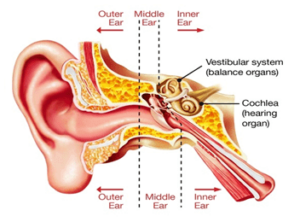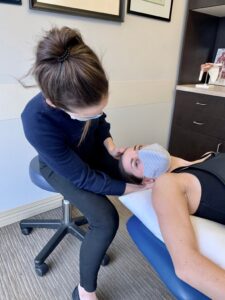Is BPPV causing your dizziness and vertigo?


Jennifer McConvey
Jennifer McConvey
If you experience dizziness or vertigo when you lie down, roll over in bed or look up, then BPPV may be the cause.
If the above scenarios and symptoms sound familiar, read on because this article will help you understand what BPPV is and what you can do to feel better.
So let’s start out with discussing what BPPV is…
BPPV
BPPV stands for Benign Paroxysmal Positional Vertigo. It’s is a benign (meaning not harmful in effect) condition involving the inner ear or vestibular system. Small calcium-rich crystals called otoconia ate housed within the centre of our inner ear. BPPV results when the otoconia (often called “ear rocks”) dislodge and travel into another part of your inner ear known as the semicircular canals.

Your semicircular canals are responsible for telling you about the rotation of your head. Therefore, the dislodged calcium crystals stimulate our canal to tell our head that we are spinning when we actually are not.
Depending on which semicircular canals the calcium crystals have displaced to, you will experience vertigo when you move your head in such a way that moves the crystals within the canal. This is why you typically do not experience vertigo in an upright sitting position, but do with certain activities like rolling over in bed, looking up, lying down.
How Common is BPPV?
BPPV is one of the most common causes of vertigo. Around 20% of all dizziness-related doctor visits are due to BPPV. Roughly 3% of the population will experience BPPV at some point in their lifetime.
How did I get BPPV?
Most often a specific cause cannot be identified in BPPV however we do know that BPPV is more prevalent in or linked to:
- Older Adults. By the age of 70, one third of the adult population have experienced BPPV at least once.
- Women. Females are two to three times more likely to get BPPV when compared to males.
- Individuals with another known vestibular condition, hormone imbalance, allergies, vitamin D deficiency or a family history of BPPV
- Individuals with a recent decline in activity level
- Recent head trauma or concussion
- Individuals who recently underwent a surgery or procedure involving a certain head position
How do I know if I have BPPV?
Typical symptoms of BPPV are vertigo, nausea, and/or vomiting. These symptoms can be vague and are symptoms of many other disorders. So how does the vertigo you experience with BPPV typically differ from other vestibular and non-vestibular disorders?
Typical BPPV signs and symptoms:
- You are experiencing short bouts of room spinning sensation called vertigo. You can have the sensation that you or the room is spinning.
- Your vertigo coincides with or is linked to certain head movements…like rolling over in bed
- Your vertigo lasts anywhere from a few seconds to less than 60 seconds
- During bouts of vertigo, you have irregular eye movements called nystagmus.
If the above sounds like what you are experiencing, contact your healthcare provider or vestibular physiotherapist, as they can confirm if you have BPPV and identify the involved canal or canals by performing positioning testing.
Check out the short clip below to see an example of what BPPV testing looks like!
What’s the Treatment for BPPV (The GOOD News!)
As mentioned earlier, BPPV can typically be diagnosed based on your history and findings on positional testing.
Canalith repositioning maneuvers remain to be the most effective treatment for BPPV with around 85% of individuals recovering. Approximately 80-90% of individuals get relief after their first treatment maneuver when performed in a clinical setting, such as vestibular rehabilitation.

During vestibular rehabilitation, a certified vestibular therapist will perform tests to identify the canal or canals affected. Once the canal or canals have been identified, treatment can be implemented by a series of head positions to help relocate the carbonate crystals back towards the centre of the inner ear.
How long does it take for BPPV to Resolve?
BPPV can typically be treated within 1 to 3 visits.
The success of BPPV treatment is dependent upon: how complex your BPPV is (involving one canal or multiple canals), if the affected canals are properly identified, and utilization of the correct treatment maneuver which also involves getting the proper head positioning to relocate the “ear crystals”.
If I had BPPV once, will I get it again?
Around 30% of individuals will experience a recurrence of BPPV within 1 year and 50% within 5 years. Since we often do not know the exact cause of most BPPV, prevention is very difficult. Medication has also shown to not be effective. If your BPPV does return, you should contact your vestibular physiotherapist.
If the crystals are in a different location, your treatment (the series of head maneuvers) will be different than before. Therefore, it’s important to be re-evaluated by a vestibular physiotherapist or a healthcare provider with experience in vestibular and BPPV.
An important point to remember is, BPPV is treatable and the maneuvers can greatly reduce your vertigo and other symptoms associated with BPPV.
Should I attempt to treat it myself at home?
As stated earlier, we have 3 canals housed within each of our 2 inner ears. Therefore, to successfully treat your vertigo you must first know which canal (and where within the canal) the particles or otoconia are. A Certified Vestibular Physiotherapist can identify all of these findings by looking at the characteristics of your nystagmus (jerk-like eye movements associated with vertigo) when performing BPPV testing. Based on your eye movements in testing, your therapist can choose which treatment maneuver to use when relocating the particles and successfully treating your BPPV.
Should I see a Vestibular Physiotherapist?
Book an appointment today to see our certified Vestibular Physiotherapist, our Dizziness, Vertigo and Balance Clinic can help with your specific conditions. If you have questions, give us a call or email us at inquiries@physioiplushealth.com
Try a free consultation
Unsure whether vestibular physiotherapy can help you? We offer a complimentary phone consultation with a certified vestibular physiotherapist to discuss your issue and provide honest advice about your treatment options.
FAQs
What does BPPV stand for?
BPPV is an acronym for “benign paroxysmal positional vertigo.”
Benign – BPPV symptoms may be severe at times, but the condition, in general, is benign or not life-threatening.
Paroxysmal – Periodic or intermittent nature of the illness. BPPV can give brief and sudden episodes of vertigo that increase in intensity and then stop.
Positional – Certain head movements or positions trigger episodes of BPPV.
Vertigo – The main symptom of BPPV is vertigo, which is the false sensation of rotational movement
Why will my BPPV not go away?
Below are some common reasons your BPPV could be lingering. (this is not an exhaustive list):
1. Unsuccessful maneuver.
2. When treating your BPPV you could have relocated the “ear rocks” into another canal leaving you with continued vertigo. This is called canal conversion.
3. More than one canal is affected.
4. There could be an additional vestibular dysfunction also causing you to have vertigo.
What medications can help treat my BPPV?
In most cases of BPPV, we are unsure of the underlying cause. We know that there are links to BPPV with certain populations, medical histories, and age ranges but for the majority of BPPV cases, the cause is unknown. Therefore, there are no medications that directly treat BPPV. Sometimes, vestibular suppressants can be prescribed to treat symptoms of BPPV like dizziness and nausea, however this is not treating the underlying cause. Canalith repositioning maneuvers are the most effective treatment when it comes to treating BPPV.
